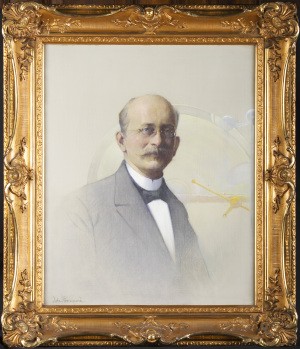
Kristian Birkeland and the Slow Dawn of Space Weather Understanding
Forskeren og oppfinneren Kristian Birkeland (1867-1917) er en ruvende skikkelse i norsk vitenskapshistorie. Han er blant annet kjent for sin nordlysforskning, og et av patentene hans la grunnlaget for opprettelsen av Norsk Hydro. I 2017 er det 150 år siden han ble født - og 100 år siden han døde. Dette markeres med en rekke arrangementer fra 13. til 16. juni. Årets Birkelandforelesning som holdes 15. juni på Det Norske Videnskaps-Akademi, inngår i jubileumsprogrammet.
Birkelandforelesningene har vært holdt årlig - med noen få unntak - siden 1987 i Det Norske Videnskaps-Akademi der Birkeland var medlem. Hans portrett, malt av Asta Nørregaard i 1903, henger i foredragssalen på Akademiet.
Professor David Southwood fra Imperial College, London har satt som tittel på sitt foredrag: «Kristian Birkeland and the Slow Dawn of Space Weather Understanding». Han blir introdusert av Ole Petter Ottersen, rektor ved Universitetet i Oslo.
Før forelesningen viser Thomas Widerberg et kosmisk medieshow.
Etter forelesningen blir det taler ved stortingspresident Olemic Thommessen og ved Yaras konsernsjef Svein Tore Holsether.
Birkelandforelesningen er et samarbeid mellom Univeristetet i Oslo, Det Norske Videnskaps-Akademi, Yara og Norsk romsenter.
Sammendrag - Kristian Birkeland and the Slow Dawn of Space Weather Understanding
In the years just before its full independence in 1905, Norway produced some of its best known sons, Henrik Ibsen, Edvard Munch, Edvard Grieg, Fridtjof Nansen and Roald Amundsen.
Just as creative and remarkable in many ways was the scientist, Kristian Birkeland. He was the man who not only would have the key insight that would open up our understanding of how solar and earth environment directly interlink but also a man who believed in applying science to immediate problems.
He was a polar explorer and yet also co-founder of what was to become the largest company in Norway, Norsk Hydro, as well as an inventor of popular renown. He died at 50 years of age, precisely 100 years ago.
The auroral polar light displays in Northern and Southern hemispheres now are seen as the most dramatic visual feature of a whole new science called space weather. Birkeland would not have been surprised but nearly all his scientific contemporaries 100 years ago would have been amazed.
Ironically, it would take another 50 years for his greatest insight that the polar aurorae were due to electrically charged particles hitting the upper atmosphere to become firmly proven by an American spacecraft and for his insights to be become generally accepted.
Why did it take so long? Partly, it was due to having ideas almost before their time and partly it was due to prejudice by a scientific establishment who were rather fixed in their way of thinking. I hope to make amends for what was largely a British establishment. We'll explore what Birkeland found, why it took so long for him to be understood and most importantly, why he does really deserve to have his picture not only on the tail of a Norwegian airplane but also on the 200Kr banknote.
